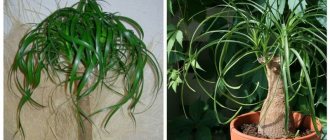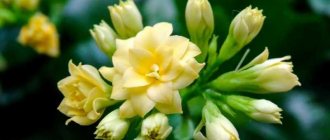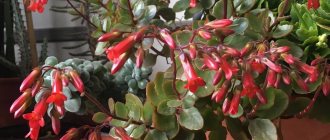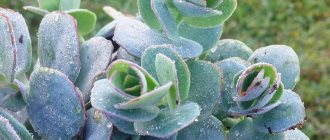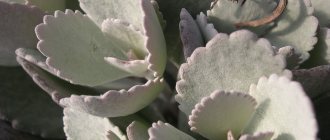They name this houseplant differently, often giving it the names of other potted plants that are similar in appearance (elephant's foot, bottle tree, horse or ponytail). It should be correctly called “bocarnea” or “nolina”. Everyday care at home for this indoor flower will not require much effort, since in its homeland it is not spoiled by nature, surviving in harsh places where rain happens once or twice a year. Thanks to its unusual shape, it has a spectacular appearance that fits harmoniously into almost any modern interior, especially high-tech and fusion, giving it a special tropical “zest.”
Light
These plants will grow slowly and although will do well in a slightly shaded location, they need bright light to thrive. If you provide some sun, within a few weeks you will see the plant turn this into lush new leaves, meaning more light means more growth.
Nolina plants grown in the shade should not be suddenly moved and thrown into a very sunny location. Move the plant to this new location for a few hours a day and then back again. Do this for a week to get used to the change in light intensity. This will prevent the leaves from becoming disfigured.
Location of bocarney house
The bottle palm belongs to the southern plants, so it loves a lot of light. Direct sunlight can damage its leaves only during the period of highest sun activity. The rest of the time they do not cause her any harm, on the contrary, bringing great benefit. If the tree is grown in the shade with insufficient light, it will grow elongated and have pale leaves. The best place to place a tree pot is the southwest, southeast and south sides of the house. If the flowerpot is placed on the south side, it is placed on a shelf or bedside table near the window, shading it from the intense sun.
Watering
At the base of Nolina there is a thick, swollen stem that has a woody appearance. It is a water storage organ that can support the plant during drought. This characteristic feature in the flower description should indicate to you that the plant is ready for long periods between waterings. An excellent houseplant for those who enjoy peace of mind and low maintenance.
Tip: If you grow your flower in a very small pot with little soil, it will dry out faster and may need more frequent watering, this is an important detail in how to water your flower.
Ideally, you should aim to water at least a few times a month (once a week in high summer if possible), and make sure it's a thorough watering.
Water supplies will support the plant if you forget to water it from time to time, but don't make it a habit or you'll end up with a struggling plant rather than a thriving one.
Description of bocarnea
Beaucarnea belongs to the Agave family, which are often found in desert areas. In the natural environment, there are more than 30 varieties of this plant, but only bocarnea reflexum is grown at home. The official name Nolina was given in honor of the French breeder P. Nolina, who studied this plant and developed some varieties based on it. Some biologists attribute this plant to the Agave family, while others to the Dracaena family. There is still no clear answer to the question of which family bocarnea belongs to. Mexico and the American South are considered the birthplace of the culture. In its natural environment, the tree grows to a height of more than 10 m.
It is characterized by the presence of a straight trunk, which has a substantial thickening near the ground, which serves as a container for storing water. In ancient times, the trunks of these plants were used by the Indians for their intended purpose - namely for storing water. Palm leaves are used to make mats and weave sombreros. The process of water accumulation occurs during the rainy season. Moisture falling on the trunk is absorbed by the caudeps cells and becomes clogged in them. At the base, the trunk expands, acquiring an irregular shape, and looks like a bottle. If the tree grows in suitable soil, it can be partially submerged underground by the lower part of the caudeps, which allows it to accumulate even more water. Thanks to these properties, plants calmly endure periods of drought, feeding on accumulated moisture. During this period, the volume of the trunk visually decreases, the bark folds and wrinkles.
The leaves have a lanceolate configuration and a very rigid structure. Young leaf plates are formed from the tops of the crown, old ones, after dying, bend down and take the form of curls. The crown of adult specimens can hang down to the ground. Drops of dew collect in the leaf axils, which are absorbed by the cells and accumulate inside the plant. During hot summer days, the leaves are laid along the axis, the water practically does not evaporate. The color of the leaf blades is uniform green, characterized by rich color. Young leaves are light green in color, while more mature leaves are dark. Some types of crops have leaves with light green stripes along them. The plant blooms with snow-white racemose flowers, 50 cm long and exuding a pleasant, delicate aroma. Flowers form at the top of the shoot and bloom in the shape of a fireworks display. Flowering can only be seen in the natural habitat of this plant. Specimens grown under artificial conditions never bloom. In order to get a properly formed tree, pinch and prune regularly. As a result, you will receive a bonsai in the form of a smaller copy of a natural bottle palm.
Temperature
When it comes to temperature requirements, unlike most houseplants, Nolina is almost hardy and can withstand sub-zero temperatures. However, when growing at home, your plant's exposure to such low temperatures will likely be an accident rather than a common occurrence, right?
To be on the safe side, try not to go below 7°C, and although higher temperatures are acceptable, you should achieve good growth at around 21°C.
Common types
Of the three dozen natural varieties in culture, the following species are most widespread.
Beaucarnea rejected
The most common variety of “bottle tree”, which has a classic shape. Lightweight and undemanding to care for, it was cultivated back in the 19th century. It has very durable leaves, which in Mexico are used as material for weaving national sombrero hats.
Beaucarnea condensed
It is valued by home gardeners for its lush, spectacular crown with straight, hard leaves. The second most popular cultivated species. Relatively winter-hardy, withstands short-term temperature drops down to -5C.
The thickening of the trunk in this variety is weakly expressed, the leaves have a bluish tint. In Mexico, this species is called bear grass. Winter hardiness is high, up to -12C.
Nolina Lindemeira
The shortest, practically without a trunk. The leaves are very thin, cord-like, dry and hard.
Nolina thin (slender)
The name of this species sounds like irony, since the thickness of the trunk is a record holder in terms of volume - in the wild in the lower part it reaches 5-7 m. It blooms only in adulthood and only in natural conditions.
Fine gravel or colored pebbles poured into a pot will prevent the formation of a soil crust and emphasize the exoticism of the crop.
How to care for nolina?
Care at home should be carried out taking into account the fact that the plant is a pronounced succulent.
Choice of location, lighting
While the majority of even light-loving indoor plants require light shading during hot midday hours from direct sunlight, nolina tolerates them calmly, so it should be placed on the brightest, southern windowsill. A little partial shade during the day will not be critical for it. However, the less light the foliage receives, the less lush it will grow. During the winter season, windowsills facing east and north require additional lighting.
Soil requirements
If bocarneya is completely undemanding in terms of soil nutrition, then it makes high demands on its moisture permeability and aeration. In the wild, it has to make do with infertile soils on rocky slab foundations, so growing nolina at home needs to be as close to them as possible. At the same time, the plant grows very slowly, so to obtain faster results, favorable conditions should be created that do not contradict the biological characteristics of the bottle tree. The substrate is made up of leaf and turf soil with a predominance of the former, peat and sand. You can add a little humus. Heavy drainage is installed at the bottom of the pot to stabilize the container. It is not recommended to use expanded clay for this purpose if the height of the dishes is not commensurate with the height of the tree.
How to water?
The issue of watering is key when growing nolina. If you place it on a southern windowsill and water it very rarely, with considerable exposure after the earthen ball has completely dried out, a stressful situation will be created, similar to growing in its homeland. In response, the plant will begin to form a thick “leg” with decorative cracks and scars that appear from the uneven expansion and contraction of the outer tissues. But the leaf rosette will begin to thin out and may droop, which will be to the detriment of decorativeness. To maintain a harmonious appearance, balance must be found. Spraying is usually not necessary for the crop, but occasional wet treatment of the leaves will be beneficial.
Bottom watering through a tray is recommended. The water should be well settled or filtered, without traces of chlorine.
Bocarnea loves summer sun-air baths outside in dry and windless weather.
During the winter season, the plant has an unexpressed dormant period; there is no need to water it at this time; it is enough to occasionally moisten the leaves by wiping them with a damp sponge to remove dust.
Top dressing
Since the vegetative mass accumulates slowly, care should be taken to ensure that there is no excess nitrogen in the soil. This element causes soft leaves and their sagging, which negatively affects the decorative effect. Occasionally, and only in the warm season, the specimen can be fed with a liquid phosphorus-potassium complex in half the recommended dose.
Temperature
Bocarnea loves warmth and does well even in hot conditions. But she needs rest and a relative rest phase during the winter season. It is desirable that the temperature at this time remains within +15C or does not differ from this indicator by more than 5⁰.
Transfer
If it grows well, it can be replanted once a year. If conditions are not so good or you want to limit the size of the plant, only replant every 2 or 3 years.
As long as you feed them about once a month, these houseplants still do well in small pots, and although most of them are above the surface, the roots can be quite compact, as seen in Nolina's photo.
When it's time to replant, there are no special soil or tips to follow. Standard everyday soil will do, just make sure it's fresh and not old or used. In terms of appearance and cosmetics, you can try using a tall container to keep the long leaves from dragging on the ground.
Diseases and Pests
- Have the leaves darkened, become limp and drooping? It's all about the lack of light! Move the plant to a brighter place or turn on a fluorescent lamp.
- Softening of the trunk occurs due to a large amount of moisture in the soil. Unfortunately, it is unlikely that it will be possible to save the bocarney.
- Drying of the trunk occurs due to lack of moisture. Adjust your watering schedule.
- Are the leaf blades starting to crack? You are feeding the plant too much nitrogen.
- Too dry air in the apartment can cause the tips of the leaves to dry out and brown spots appear on them.
With proper care, bokarneya almost never gets sick . However, it is not immune from the appearance of pests. Scale insects and spider mites often appear in dry air.
The algorithm for fighting both the first and the second is the same.
- If there are a lot of adult pests, collect them by hand. Since the size of an adult bocarnea does not allow it to be rinsed in the shower, soak a cotton swab in a soapy solution and wipe the outside of the leaves, trunk and caudex. Instead of soap, you can add ammonia, turpentine or hydrogen peroxide to the water. This may be enough if the pests have just appeared and have not had time to reproduce. Be sure to remove cobwebs, dried and severely damaged leaves.
- Treat bokarnia with a suitable preparation. To begin with, you can use a folk recipe: infusion of calendula, dandelion, decoction of dope, celandine, garlic or onion.
Of the biological products , “Agravertin”, “Vertimek”, “Fitoverm”, “Akarin” .
The last link in the pest control chain is acaricides and insecticides (Apollo, Oberon, Nisoran, Sunmite, Flumite, Aktara). When carrying out treatment, protect mucous membranes and skin from contact with drugs; after work, be sure to ventilate the room; if possible, carry out treatment outside.
Don’t forget to treat the pot, window sill, glass with a disinfectant, and wash the curtains if the plant touched them with leaves. Pests can also be found there.
Do not wipe the back side of the leaves with soapy water - the foam will clog the stomata (channels for air exchange). Make sure that soapy water does not get into the soil - this will damage the plant.
Reproduction
Propagation of the Nolina palm is quite difficult because it is usually done through periodic displacements. The difficulty is that the offsets depend on the parent plant and do not take root very quickly. This means that if you separate the shoot too early, it will rely on you.
If you try to propagate, you can use rooting hormone to increase your chances. Then you should stick to indoor care.
To grow Nolina from seeds, you need to maintain high humidity and temperature; small greenhouses made of polyethylene or a plastic bottle will help with this. Simply cover the soil to create these conditions. The seeds are placed on moist soil and covered with a 1 cm thick layer of soil. The temperature should be +20 +23, the light is bright and diffused. After the shoots appear, you need to wait for them to get stronger before further transplanting into separate pots.
Possible problems during cultivation
- The trunk does not thicken, but grows upward. The reason is lack of lighting and too frequent watering. It is necessary to move the plant to a bright place and practice regular but moderate dry periods.
- The leaves of the lower tier dry out and fall off. The situation is not problematic because a natural process is taking place. It is better not to tear off dried leaves, but carefully trim them with sharp scissors.
- The ends of the leaves dry out. Despite the plant's drought resistance, it sometimes suffers from excessive dry air, since it is naturally moistened by morning dew. The problem especially often occurs in winter when kept in a room with central heating. Help - light spraying with soft, settled water without chlorine. The first time is every day early in the morning.
- The trunk shrinks, decreases in volume and dries out. Usually this process is observed after a long winter, in this case it is natural. In spring, the tree will begin to accumulate moisture again.
- The leaves become soft and do not form a beautiful “hair”. The reason is an excess of nitrogen in the soil.
- Leaves that are not located at the bottom of the rosette dry out, or all the foliage becomes paler. This could be a sign of dangerous root rot. The reason may be excessive watering, especially in the cold season, as well as drafts, which bokarneya is very afraid of. If root rot is suspected, the plant should be removed and the roots examined. Rotten parts are carefully removed. If rot has affected the trunk, the damaged part should be cut out and the cut should be sprinkled with ash. If the area of the rotten part is large, the plant will most likely die.
Growth rate
Expect very slow or no growth if light levels are low or you don't follow step-by-step care tips. Under favorable conditions, you will still experience slow growth!
The simple truth about these plants is that they are slow growers. This is good if you don't want it to outgrow the space, but not so good if you want it to quickly grow into a tall and stately plant.
Is Nolina poisonous?
No, the flower is not toxic to dogs, cats or people. Although you should keep it away from pets as they may be mistaken for a toy and will be damaged by sharp claws or curious teeth.
How to care: summary
Medium to bright light. Preferably good light with some sun. Avoid dark areas.
Watering from low to moderate. Water well, and then don't water again until the potting mix is almost completely dry.
Temperature. A warm room with a temperature of about 21 ° C is necessary, otherwise the plant will not grow.
Feeding. Use liquid fertilizer once a month (or less often).

